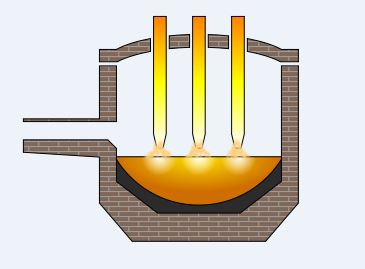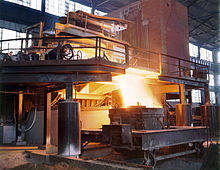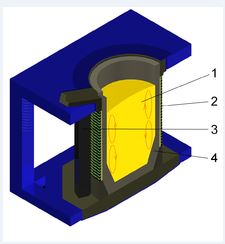Blast furnace
Blast furnace in its primitive form as Catalan Forge and Stukofen continued in use for iron making up to 17th century a.d. Charcoal was used as reducing agent. Charcoal is friable and
imposed severe restriction on increasing the height of the furnace. The increasing cost of charcoal and requirement of large forest areas led to more restriction on use of charcoal for
iron making. The smelters found coal as an alternative to charcoal.The engineers like Dud Dudley and Abraham Darby successfully used coal for producing coke and further use in smelting
of iron. John Wilkinson used steam engine for production of powerful air blast to be used in the furnace. Bunsen & Playfair initiated steps for use of exhaust gases. In the year 1829 a.d,
an engineer from Scotland named Nelson attempted the use of hot blast in the blast furnace. Another engineer named as Cowper developed a stove to generate hot blast for the blast furnace
in 1857a.d. Electrostatic Precipitator was developed by Cotrell for cleaning exhaust gases. To increase the production of the blast furnace, quality lime stone were used along with iron ore and coke. Initially the charging of iron ore, quantity of charging materials increased,
coke and lime stone were carried out manually. When the quantity of charging materials increased, semi-automatic and automatic chargers were used.
To maintain uniformity in the charging material, skip hoist chargers were developed and used. The entire operation of the furnace became automatic from time to time. Initially liquid
pig iron was cast into sand cups. But due to increase in the output of the furnace, regular casting was necessary. During 1984a.d, pig casting machine was developed by Wehling.
The development of open hearth, hot metal practice for stocking of molten iron for further production of steel was possible during the early part of 20th century. Casting of pig iron
was carried out for foundry grade pig iron. The general outline for modern blast furnace was developed during middle part of 20th century. To increase the production, the size was
increased. The use of sinter and oxygen enriched blast improved the production level of blast furnace. The use of non-coking coal in the blast furnace reduced the cost of production of
iron. The automation of the blast furnace made the production of pig iron cheaper and convenient.
BLAST FURNACE PLANT
The Blast Furnace plant consists of the following important sections:
a) Blast Furnace proper.
b) Hot Blast supply equipments
c) Gas cleaning systems.
d) Raw material storage and handling
e) Liquid product disposal
f) Process control equipments
A Blast Furnace is a tall circular steel structure with fire bricks lining in the inner side. A blast furnace is nearly 30m tall with a circular cross section at different levels.
The structure of a blast furnace consists of foundation, hearth, bosh, mantle, columns, stack, raw material hauling and charging facilities. The dimensions of the furnace producing
2000 tones per day are given below:
a) Hearth diameter:-8-9m
b) Bosh diameter:-9-10m
c) Hearth height:-3-3.5m
d) Bosh height:-3-4m
e) Stackline diameter:-5.5-6.5m
f) Stack height:-18-20m
g) Total height :-30-32m
h) Working height :-21-24m





